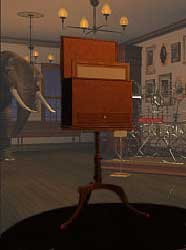The Amusement Devices ExhibitThe Lost Museum Archive

Decades before the advent of motion pictures, or even electricity, showmen like P. T. Barnum used all manner of technology to dazzle nineteenth-century audiences. The American Museum’s Lecture Room employed the latest stagecraft—including lavishly painted backdrops and mechanical and pyrotechnic displays onstage—to add spectacle to its moral dramas. The museum also displayed automata that imitated human and animal behavior and lantern slide shows, cosmoramas, and panoramas that presented images in new ways. While the Portable Seriate Slide Cabinet (which offers visitors to the virtual American Museum a short history of "The Slave Owner Conspiracy") did not actually exist, it represents the kinds of innovative presentational technologies that Barnum regularly used. At the American Museum and other nineteenth-century sites of public amusement, technology and entertainment went hand in hand.